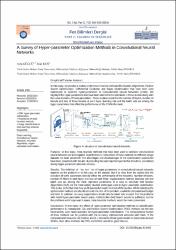| dc.contributor.author | Gülcü, Ayla | |
| dc.contributor.author | Kuş, Zeki | |
| dc.date.accessioned | 2021-06-11T10:51:51Z | |
| dc.date.available | 2021-06-11T10:51:51Z | |
| dc.date.issued | 2019 | en_US |
| dc.identifier.citation | GÜLCÜ, Ayla & Zeki KUŞ. "Konvolüsyonel Sinir Ağlarında Hiper-Parametre Optimizasyonu Yöntemlerinin İncelenmesi". Fen Bilimleri Dergisi, 7.2 (2019): 503-522. | en_US |
| dc.identifier.uri | https://dergipark.org.tr/tr/pub/gujsc/issue/45674/514483 | |
| dc.identifier.uri | https://hdl.handle.net/11352/3606 | |
| dc.description.abstract | Konvolüsyonel Sinir Ağları (KSA), katmanlarının en az bir tanesinde matris çarpımı yerine konvolüsyon işleminin kullanıldığı çok katmanlı yapay sinir ağlarının bir türüdür. Özellikle bilgisayarlı görü çalışmalarında çok başarılı sonuçlar elde edilse de KSA hala birçok zorluk içermektedir. Daha başarılı sonuçlar elde etmek için geliştirilen mimarilerin giderek daha derinleşmesi ve kullanılan görüntülerin giderek daha yüksek kalitede olmasıyla daha fazla hesaplama maliyetleri ortaya çıkmaktadır. Hem bu hesaplama maliyetlerinin düşürülmesi, hem de başarılı sonuçlar elde edilebilmesi, güçlü donanımların kullanılmasına ve kurulan ağın hiper-parametrelerin optimize edilmesine bağlıdır. Bu çalışmada, Genetik Algoritma, Parçacık Sürü Optimizasyonu, Diferansiyel Evrim ve Bayes Optimizasyonu gibi yöntemler ile KSA optimizasyonu gerçekleştirilen çalışmalar incelendi. Bu çalışmalarda optimize edilen hiper-parametreler, tanımlanan değer aralıkları ve elde edilen sonuçlar incelendi. Buna göre, KSA’ nın performansında en etkili hiper-parametrelerin filtre sayısı, filtre boyutu, katman sayısı, seyreltme oranı, öğrenme oranı ve yığın boyutu olduğu görülmüştür. Aynı veri kümelerinin kullanıldığı çalışmalar, elde edilen doğruluk değerleri açısından karşılaştırıldığında çoğu veri kümesi için en iyi doğruluk oranlarının popülasyon tabanlı yöntemlerden Genetik Algoritma ve Parçacık Sürü Optimizasyonu kullanılan çalışmalarda elde edildiği görülmüştür. Bu üst-sezgiseller ile elde edilen modellerin performanslarının “state of the art” modellerle yarışabilir durumda hatta bazen daha iyi oldukları görülmüştür. Yine üst-sezgisel kullanılan bazı çalışmalarda üretilen modellerin aşırı büyümesi engellenmiş; basit ve kolay eğitilebilir modeller üretilmiştir. Hesaplama maliyeti açısından çok avantajlı bu basit modeller ile literatürdeki karmaşık modellere çok yakın sonuçlar elde edilebilmiştir. | en_US |
| dc.description.abstract | Convolutional neural networks (CNN) are special types of multi-layer artificial neural networks in which convolution method is used instead of matrix multiplication in at least one of its layers. Although satisfactory results have been achieved by CNN especially in computer vision studies, they still have some difficulties. As the proposed network architectures become deeper with the aim of much better accuracy and the resolution of the input images increases, this results in a need for more computational power. Reducing the computational cost while at the same time still having high accuracy rates depend on the use of powerful equipments and the selection of hyper-parameter values in CNN. In this study, we examined methods like Genetic Algorithms, Particle Swarm Optimization, Differential Evolution and Bayes Optimization that has been used extensively to optimize CNN hyper-parameters, and also listed the hyper-parameters selected to be optimized in those studies, ranges of those parameter values and the results obtained by each of those studies. These studies reveal that the number of layers, number and size of the kernels at each layer, learning rate and the batch size parameters are among the hyper-parameters that affect the performance of the CNNs the most. When the studies that use the same datasets are compared in terms of accuracy, Genetic Algorithms and Particle Swarm Optimization which are both population-based methods achieve the best results for the majority of the datasets. It is also shown that the performance of the models found in these studies are competitive or sometimes better than those of the “state of the art” models. In addition, the CNNs produced in these studies are prevented from being overgrown by imposing limits on the hiper-parameter values. Thus simpler and easier to train models have been obtained. These computationally advantageous simpler models were able to achieve competitive results compared to complicated models. | en_US |
| dc.language.iso | tur | en_US |
| dc.publisher | Gazi Üniversitesi | en_US |
| dc.relation.isversionof | 10.29109/gujsc.514483 | en_US |
| dc.rights | info:eu-repo/semantics/openAccess | en_US |
| dc.subject | Derin Öğrenme | en_US |
| dc.subject | Konvolüsyonel Sinir Ağları | en_US |
| dc.subject | Sezgisel Algoritmalar | en_US |
| dc.subject | Hiper- Parametre Optimizasyonu | en_US |
| dc.subject | Deep Learning | en_US |
| dc.subject | Convolutional Neural Networks | en_US |
| dc.subject | Heuristic Algorithms | en_US |
| dc.subject | Hyper-Parameter Optimization | en_US |
| dc.title | Konvolüsyonel Sinir Ağlarında Hiper-Parametre Optimizasyonu Yöntemlerinin İncelenmesi | en_US |
| dc.title.alternative | A Survey of Hyper-parameter Optimization Methods in Convolutional Neural Networks | en_US |
| dc.type | article | en_US |
| dc.relation.journal | Fen Bilimleri Dergisi | en_US |
| dc.contributor.department | FSM Vakıf Üniversitesi, Mühendislik Fakültesi, Bilgisayar Mühendisliği Bölümü | en_US |
| dc.identifier.volume | 7 | en_US |
| dc.identifier.issue | 2 | en_US |
| dc.identifier.startpage | 503 | en_US |
| dc.identifier.endpage | 522 | en_US |
| dc.relation.publicationcategory | Makale - Uluslararası Hakemli Dergi - Kurum Öğretim Elemanı | en_US |
| dc.contributor.institutionauthor | Gülcü, Ayla | |
| dc.contributor.institutionauthor | Kuş, Zeki | |



















